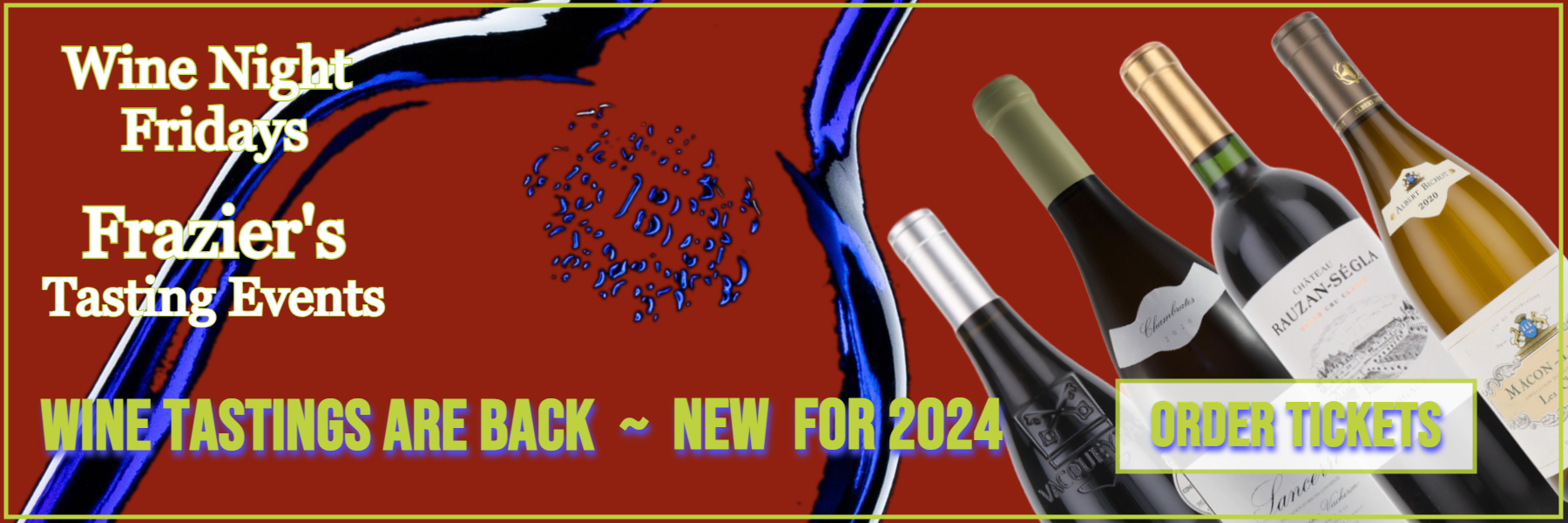A new year brings opportunities to try something new. In the world of wine, there's always something you've never tasted, or an old faithful with its latest release. Go on, give it it try. After all, it's simply fermented grape juice (wine, to you and me).
There are only two ways to drink wine. Firstly, on its own and, secondly, with food. Easy, really! How you enjoy yours is up to you, but the event will be a major decider on which wines are chosen. Parties, weddings, family dinners, business events, or a relaxing glass after work. It's unlikely that the same bottle will fit all of these different occasions. Price is always a factor in choosing a wine, personal taste (why drink something you don't like?), following a trend and, for me, quality has to be number one in determining which wine I have. But how to decide between the countless thousands of wine on the market?
First, try getting some recommendations for your chosen style (Frazier's can help with this). Let's say that it's a straightforward red for drinking after work. You've had three suggestions including a Rioja, a Shiraz and a Malbec.
The Rioja is an oak aged "Crianza" wine made from 100% Tempranillo grapes. The second is a young, unoaked Australian Shiraz and the final wine is an organic Malbec from Argentina which has also seen no influence of oak.
So, which one to pick? It's down to deciding on the wine you enjoy the most. Don't be swayed by convention, just go with the flow. It's your decision alone. I can assure you that you'll be able to pick a winner out of the three. Perhaps, you'll love all of them, but one will have the edge on the day, so be confident in your selection!
Even if you've never tried any of these wine styles, you're quite likely to have a new favourite after the tasting evaluation session is over and you've ordered your first case.
But how seriously should you taste these three wines? A wine professional has a method for evaluating a wine's quality, typicity of style, it's value and potential for development/ageing, but even for a first try, a small amount of preparation is required. Make sure you have enough clean glasses of a similar size and shape for each wine. If you use dirty glasses the flavour can be affected in a bad way and a perfectly good wine will be wasted. The style of glass will alter the way the aroma is judged, so making them the same will remove the possibility of a poor judgement against a particular wine. Most of a wine's flavour is actually derived from its aroma characteristics, so a glass which concentrates this is best for tasting purposes. Try using an ISO tasting glass, one which tapers inwards at the top, for consistent results. Different shape glasses can have a remarkable effect on the apparent quality of a wine. Expensive, varietal specific wine glasses are available which really do make a difference, but it can be a wallet-busting experience to obtain a suitable mix for even a simple tasting. Riedel wine glasses can easily cost over £50 each, whereas the ISO ones are only a few pounds.
I once had a Canadian ice-wine poured into an ISO glass and was then told to pour half of the wine myself into a Riedel glass made specifically for the winery (Inniskillin, I think it was). Tasting and comparing the same wine, the result of using the Riedel glass was unbelievable. The shape of the glass put the wine onto just the right portion of my tongue to accentuate the quality of the wine. It must be magic, it couldn't be the same wine... but I poured it myself. Wow!
Reds taste best at room temperature, but if it's a warm day, you might need to chill the wines in the fridge for half an hour before tasting. Too cold, you'll lose the aroma and the wine's tannins will be accentuated and will have a metallic taste; too warm, and it'll be more like drinking soup. On the other hand, whites and rosé need longer in the fridge to bring out their acidity. A badly made white, served too warm, will be flabby and out of balance. You won't like it at all.
Make sure to taste wines before preparing or cooking food, preferably away from other strong smells. You want to judge the wines, not what you had for lunch.
Imagine yourself at a trade tasting... hundreds of wines to taste... you can't drink them all, can you? In fact, you shouldn't DRINK any of it. Taste it and spit it out. You palate will thank you for it and you'll survive the day without any after effects.
Mastering the Art of Wine Tasting: A Guide to Professional Tasting Techniques
Introduction:
Wine tasting is a captivating journey that invites enthusiasts to explore the complex and nuanced world of flavours and aromas. While many may enjoy a glass of wine casually, the art of tasting like a professional requires a refined set of skills and a heightened sensory awareness. I'll delve into the key elements that contribute to the mastery of wine tasting, from visual examination to the appreciation of aromas and flavours, and finally, the assessment of the overall quality of the wine.
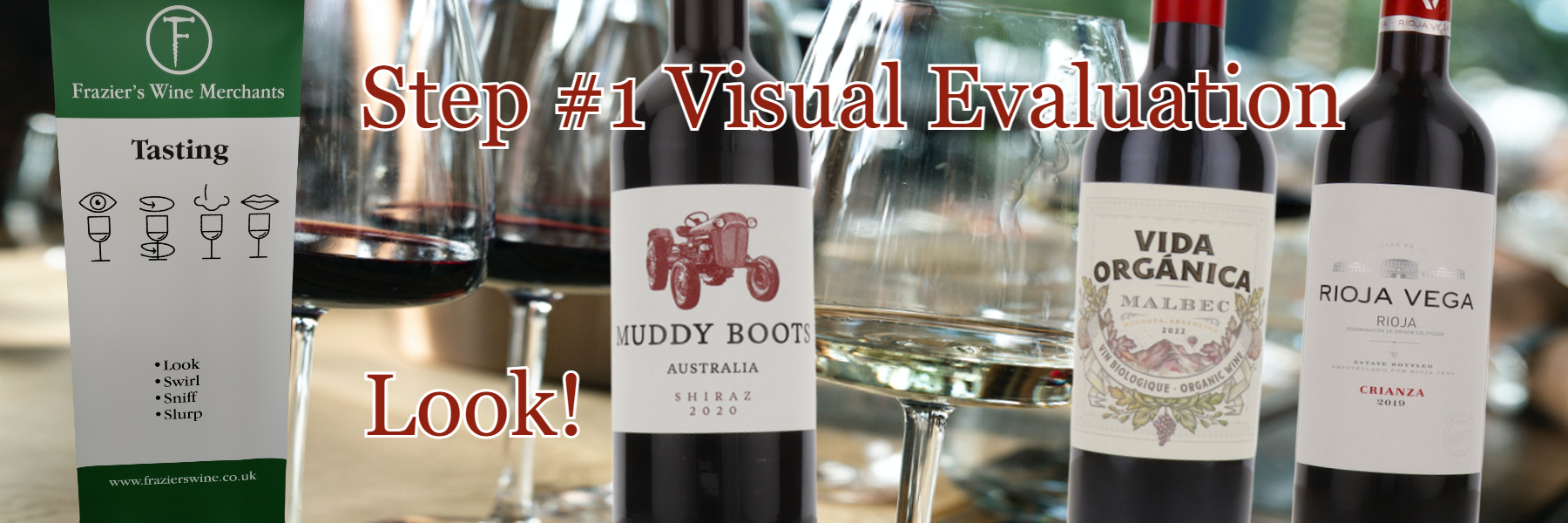
I. Visual Evaluation:
The first step in wine tasting is often to evaluate the wine's appearance. A professional taster will begin by observing the wine's colour and clarity. Hold the glass against a white background and take note of the wine's hue, which can provide insights into its age and grape variety. Younger wines typically display vibrant, intense colours, while older wines may exhibit a more subdued palette with brick or amber tones.
Additionally, observe the wine's clarity and viscosity. A clear wine suggests proper filtration and ageing, while a cloudy appearance may indicate potential faults. Cloudy wines can also be an intentional choice by the winemaker who has decided to take a more "natural" approach and has bottled the wine unfined and unfiltered. Swirl the wine gently in the glass to observe the "legs" or "tears" that form on the sides. These can offer clues about the wine's alcohol content and body.
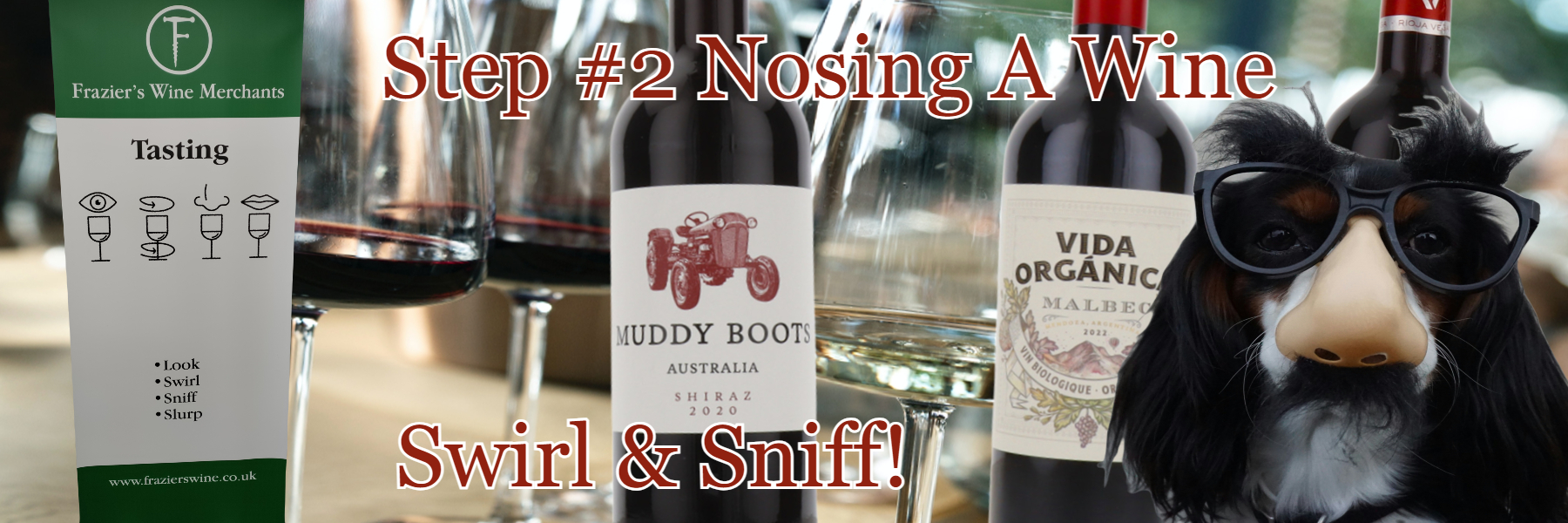
II. Aromas:
I mentioned earlier that most of the "taste" of a wine is derived from its aroma. So, if you've got a cold, everything is going to be bland, tasteless and very disappointing. Try again another day.
The second stage of wine tasting involves the exploration of aromas. Begin by gently swirling the wine in the glass to release its bouquet. Insert your nose into the glass, inhaling deeply to capture the full spectrum of scents. Go with your first impression as constantly re-nosing a wine can dull the senses due to a gradual build up of alcohol molecules.
Some wines can have such a pronounced aroma that you almost don't need to drink them to experience maximum enjoyment. I once had an old bottle of Trimbach Cuvée Frederic Emile Riesling which was like this. A beautiful, deep gold colour and an absolutely stunning nose and, when my head had cleared, on eventually taking a first sip, the flavour matched the aroma intensity and complexity. A definite "wow" wine. I can count these on one hand.
Professional tasters often categorise aromas into primary, secondary, and tertiary notes.
Primary aromas are those directly related to the grape variety and include fruit, floral, and herbal scents. Secondary aromas arise from the fermentation process and may include hints of yeast or oak. Tertiary aromas develop during ageing and maturation, showcasing characteristics like leather, tobacco, or nuttiness. Developing a vocabulary for these aromas enhances the ability to articulate and appreciate the complexity of a wine's bouquet.
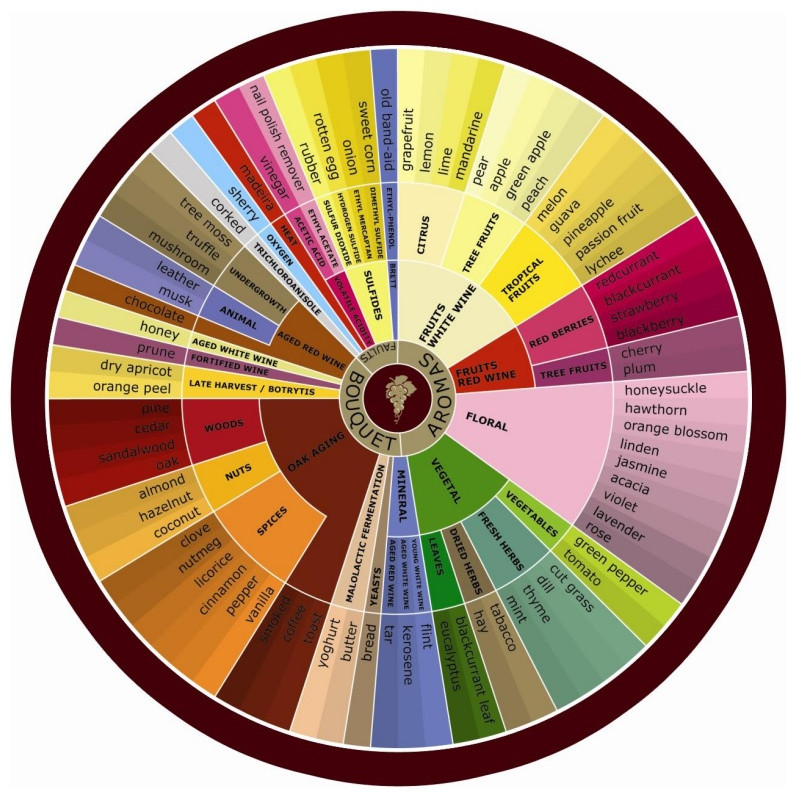
Get hold of a "Wine Aroma Wheel", or rely on your personal experiences and memories of all these characteristics found in wines. The inner ring gives you the basics to look for first of all, while the outer ring shows a selection of more detailed and specific aromas and flavours. Why not try to work out a wine's profile whenever you try something new? It's all good practise in identifying bottles in blind tastings. If you've already seen the label, you'll probably pre-judge the results and that's not playing the game!
Common terms used for both aromas and flavours are a useful way of expressing the character of any wine and will help you focus your description. It's all very well saying, "It smells like the front garden at #22 Acacia Avenue", but only you have experienced it. The clue might be in the name of the road, "Acacia", which puts it firmly in the "floral" category. You've probably not paid attention in the past, but the garden might well have an Acacia tree growing there and the smell of it has triggered your memory. Personal notes can get a bit weird, so try not to use them if you can.
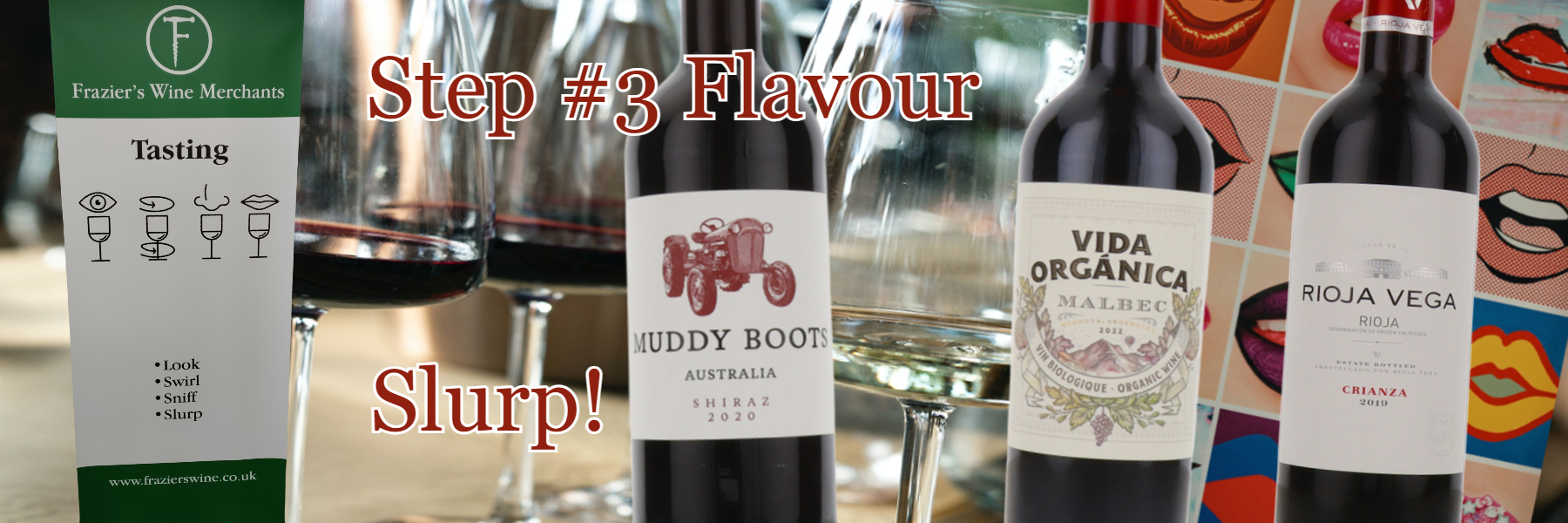
III. Flavours:
Now, I expect this is the bit you've been waiting for. Am I right? I thought so!
Your mouth can be used to judge many things, including acidity (on the tip of the tongue), tannin levels (on the side of the mouth), weight and "mouthfeel" of a wine and a myriad of flavours from the sensors covering all of your tongue's surface. Remember to steer clear of all makeup and lipstick at a tasting as it will noticeably affect the results and the glasses are a nightmare to clean afterwards!
The third aspect of professional wine tasting involves analysing the wine's flavour profile. Take a small sip and let it coat your palate. Consider the balance between sweetness, acidity, tannins (for red wines), and alcohol. Identify the primary fruit flavours, discern any secondary notes from oak or fermentation, and recognise the subtleties that evolve as the wine lingers on the palate.
Pay attention to the wine's structure, including its body, which can range from light to full-bodied, and its finish, which is the lingering impression after swallowing. A wine's "finish" can still be evaluated if you spit it out (as you should at a tasting) as the sensation can last up to a minute for a really top quality wine.
Professional tasters and sommeliers often use a systematic approach, such as the grid method, to objectively evaluate and compare different wines.

IV. Conclusion:
For every wine you'll need a way of identifying the quality of its colour, aroma and palate. One way is to allocate a potential 5 point score for each of these categories with a another 5 points awarded for the overall quality and potential for development. Add them all up and you have a score out of 20. In my opinion, a score of 15 and above would indicate a wine worth trying, but there are many wine trade professionals who prefer to use the Parker 100 point system. Over the years, scores of 80+ are considered to be unacceptable and wines need to reach 90-95 points to be treated as serious bottles! This is effectively another version of the "20 point" system as wines rarely get rated below 80 points. Some wine journalists love giving 99/100 points and even the ultimate 100/100 score, but it makes no sense to have too many wines considered to be perfect. There's always something better at the next tasting. What score will that achieve which makes sense?
My own preference is to use a simple 3 point scale (with zero being given to faulty wines, or those which are just poor/undrinkable). It's a very easy system to use. Giving a wine 3/3 means it's utterly mind-blowing quality. The best example of a style you've ever tasted, so don't use it on everything you like. A wine worthy of 2/3 is very good to excellent and a bottle scoring 1/3 is OK, but not something you'd buy a second time. Acceptable, but just dull. If you're comparing a large number of similar style wines, it might be difficult to rank all of them easily, and adding a "half point" to the scale can sort the wheat from the chaff. There's nothing to say you can't re-taste wines against each other to determine a final ranking. You are the judge and jury, but other people's opinion can be very different to your own, so don't be worried if your "new favourite" wine is disliked by everyone else at a tasting. It just means there's more wine for you. In conclusion, pick your own winner and enjoy drinking it. That's why it was made by the winemaker. Especially for you.
Mastering the art of wine tasting requires a combination of knowledge, practise, and a heightened sensory awareness. From the visual examination to the appreciation of aromas and flavours, each step contributes to a comprehensive understanding of the wine in the glass. Engaging in wine tasting like a professional not only enhances the enjoyment of this ancient and sophisticated beverage but also opens the door to a lifelong exploration of the diverse and rich world of wines. Cheers to the pursuit of wine excellence.
If all of this has whetted your appetite for wine tasting, Frazier's has a programme of instore events throughout the year.
All of the below events at the wine studio are £20 per person. Events start at 7:00pm and finish at 8:30pm.
Tickets available here.
| 23rd February | Vive La France! |
| 8th March | Introduction to Wine Tasting |
| 12th April | Marvellous Malbec |
| 26th April | Wines of South Africa |
| 10th May | Sauvignon Blanc |
| 7th June | Rosé Wines |
| 21st June | English Wines |
| 5th July | There must be a Riesling for it?! |
| 19th July | Sparkling Wines |
| 20th September | Wines of Italy |
| 4th October | Rockin` Rioja |
| 22nd November | Wines for Christmas |
| 6th December | Port |
If you're a "foodie", Frazier's has teamed up with our favourite gastro pub, The Hatton Arms, near Warwick, for a season of memorable, themed wine and dine evenings.
The first event of the new year is on the horizon and this time we're heading to France.
Join Frazier's wine expert, Steve Jay, at 7.30pm on Thursday 25th January 2024 for the latest in the series of incredibly popular wine and food tasting evenings!
On the "tapas style" menu this month:
- Fresh shellfish fritters with classic tartare sauce
- Grilled chicken, orzo pasta with avocado lettuce wraps
- Poultry a la moutard
- Seared pheasant breast with puy lentils & pancetta
- Tarte fine aux pommes
Wines:
- Les Vignobles Foncalieu Piquepoul Rosé
- Chants de Closeau Vermentino
- Fleurie Presidente Marguerite
- Roche de Belanne Carignan
- Muscat Beaumes de Venise Domaine Coyeux
All this for just £45 per person.
Places are booked directly through The Hatton Arms. Deposit required at time of booking.
Email sward@hattonarms.com or call 01926 492427 to book your place today.
Contact the venue for all future nights in 2024. February's event is due to feature the wines of Argentina. Details TBC


